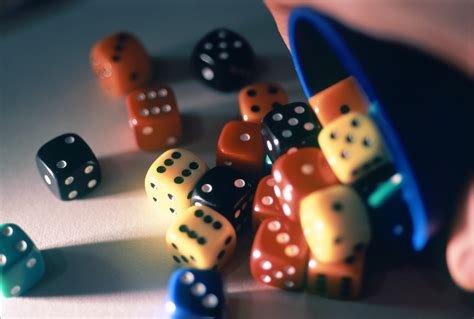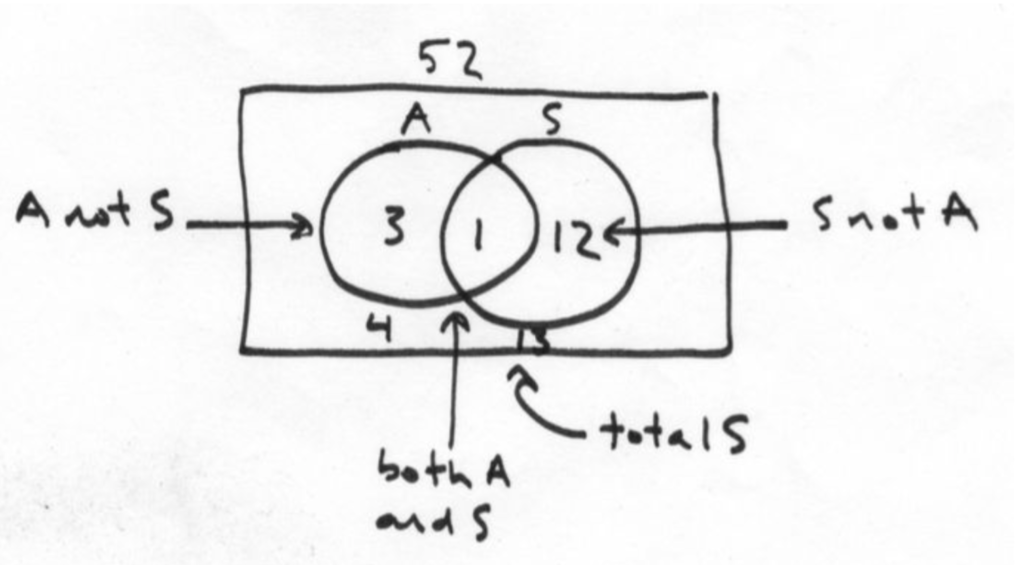
Independent vs. Dependent Probability in GMAT Probability Questions — What is the Difference?
It would be really easy to dive into a thoroughly flummoxing explanation of the difference between Independent and Dependent Probabilities, but I’ll spare you that.
In other words, a technical proof of this is somewhat mind-bending, so we’ll leave it here with a few real-world examples.
We can define each type in terms of, naturally, gambling games. Remember: Math for Degenerates.
Let’s start with…
Independent Probability in GMAT Probability Questions
Independent Probability, for our purposes, basically means that if we calculate multiple Probabilities, each of those will “recycle” or be the same–completely unaffected by the Probabilities that came before.
That’s like rolling dice, flipping a coin, or spinning a roulette wheel9. Each Probability, assuming the game is working correctly (that is, the dice aren’t loaded or the wheel doesn’t stick in the wrong place), et cetera, will be exactly the same for each turn.
It would also be possible to engineer an Independent Probability out of, say, pulling the Queen of Hearts from a deck of cards in one of three pulls. If you pull one card and then replace it, the Probability is 1/52 every single time!
However, dice gives us a nice balance of options, so let’s use that as our example:
Not to offend any Dungeons and Dragons fans out there, but let’s work with a six-sided die because that’s what is traditionally used in a Western casino.
What is the Probability of rolling a 3 if the die is thrown once?
This should be fairly straightforward: the desired outcomes a re simply 1. That is, rolling a 3. The
total outcomes are simply all the possibilities: 6. Thus, the Probability of rolling a 3 is 1 out of 6 or 1⁄6.
This should be fairly straightforward: the desired outcomes a re simply 1. That is, rolling a 3. The total outcomes are simply all the possibilities: 6. Thus, the Probability of rolling a 3 is 1 out of 6 or 1⁄6.
However, let’s say that we’re looking for a Three the next time that we roll the dice. The Probability for that particular throw is still one possibility (the Three) out of the total possibilities (all 6), so it would be 1⁄6 again.
In fact, no matter how many times you throw the dice, the Probability for each throw is exactly the same.
Note that this is NOT the same as to suggest the Probability that we roll a 3 each time. That’s something different, which we will discuss shortly–feel free to hold your breath–it won’t take long.
A Note on the Gambler’s Fallacy in GMAT Probability Questions
This is actually a really important idea in business and life, and applies to a lot more than GMAT Quant. It applies to GMAT Critical Reasoning, too!
Let’s say that you’re a gambler flipping a coin, equally likely to land on Heads or Tails. You’ve flipped seven Heads in a row! You’re hot, man, on a winning streak. That next one just has to be a Head, right?
This is actually a really important idea in business and life, and applies to a lot more than GMAT Quant. It applies to GMAT Critical Reasoning, too!
Let’s say that you’re a gambler flipping a coin, equally likely to land on Heads or Tails. You’ve flipped seven Heads in a row! You’re hot, man, on a winning streak. That next one just has to be a Head, right?
In fact, it must have a much higher likelihood of being a Head, doesn’t it? Yeah… no.
Actually, the Probability that you’ll get a head on this flip is exactly the same as for all the others: 1⁄2. In other words, past outcomes don’t predict the future.
Remember, each time you flip, the Probability recycles. Each time it is exactly 1⁄2. This doesn’t change.
This is the Gambler’s Fallacy. It’s a bit like saying “because my parents each had a stable job and a company pension, I’ll definitely have a stable job and a company pension.” Let me know how that works out for you…
It also works in reverse! That would be like assuming the next one must be a Tail, or “because every US President in history has been a man, the next one has a higher likelihood of being a woman.” Just like 2016…
Now–you’d be correct to notice that something does in fact change here. This is what might be confusing your intuitive sense.
What’s changing is, of course, not the Probability of the particular outcome, but of getting a particular series of outcomes.
In other words, achieving this outcome for eight flips…
TTTTTTTT
…is going to be one hell of a lot less likely than achieving this outcome (or one of its variants):
TTTTHHHH
How do we deal with this? Well, that’s the entire topic of the chapter on Probability per Distribution, so stay tuned.
Check out more GMAT Probability resources here!
Dependent Probability in GMAT Probability Questions
The concept of Dependent Probability is best described by different sorts of games, such as those that involve drawing cards from a deck (when not replaced), such as Poker or Blackjack.
In other words, you’re taking stuff out of the larger group, yet you’re not replacing it with each turn. What that means, in effect, is that as you continue to increase the number of turns, the total possibilities decrease.
In yet other words, the damn denominator invariably decreases.
However, depending on what you’re looking for, the numerator either decreases or stays the same.
Let’s look at an example:
Three cards are selected at random from a deck of cards, without replacement. What is the Probability that all three of the drawn cards are Aces?
This is pretty straightforward: we know–hopefully we’re clear by now–that we start with four Aces out of 52 total cards.
That means the Probability in the first selection is simply 4/52.
Then, for the second selection, things change a bit. Remember, we haven’t replaced anything. That means that this time we only have three Aces to choose from… and also 51 total cards to draw from.
That means the Probability in the second selection is 3/51.
Likewise, the Probability for the third selection is affected by the first two selections.
We’ve removed two Aces at this point, so we have two more Aces to choose from… but we’ve removed three cards, which gives us 50 total cards to choose from:
That means the Probability in the third selection is 2/50. Thus, the Probability that all of three are Aces, which we’ll represent as…
P(A)*P(A)*P(A)
…is simply this:
(4/52)*(3/51)*(2/50)
If I cared, I could break this down and give you a final number answer. For the moment, that’s not important.
PROPER SETUP is the key to all Probability questions, and we have that sorted out, so let’s not confuse ourselves with details until we get to full sample questions.
If you’re still skeptical, let’s look at another example:
Three cards are selected at random from a deck of cards, without replacement. What is the Probability that NONE of the drawn cards are Aces?
OK, this should be easy. Start with this: we know that we have 52 total cards, so that’s out of the way. How many cards ARE NOT ACES? 52 – 4 = 48, of course.
That means the Probability for the first selection is 48/52.
Likewise…
That means the Probability for the second selection is 47/51.
Likewise…
That means the Probability for the third selection is 46/51.
Following on, the Probability that all of three are NOT Aces, which we’ll represent as…
P (− A) * P (− A) * P (− A)
…is simply this:
(48/52)*(47/51)*(46/50)
That’s it–done.
Another Example of Dependent Probability in GMAT Probability Questions
A simple case of this would be to look again at a cards example:
If two cards are drawn simultaneously and at random* from a deck of 52 cards, what is the Probability of pulling two Aces?
This is as simple as the Probability of pulling an Ace the first time ( 4/52 ) times the Probability of pulling an Ace the second time ( 3 /51). Note that the decrease in numerator and denominator of the second Probability account for the first selection already being removed.
(4/52)*(3/51)
Note that both of these fractions easily reduce, leaving us with:
(1/13)*(1/17)=1/221
*A statement such as “simultaneously and at random” is traditionally used to indicate that there is no underlying pattern to the shuffling of the deck; it still means that the first selection impacts the second selection–even if they happen “simultaneously.” That is, it DOES NOT imply that the Probability here is somehow (miraculously) Independent.
CONCLUSION
Do you need to know the terms Independent and Dependent? Like many things on the GMAT, not technically, I guess–if you can do the operation, knowing its name doesn’t really help anything. I don’t have to know what a hammer is called just to be able to hit a nail, yes?
However, you need to know how to identify the different situations–does the Probability recycle each turn OR is the Probability of the next turn dependent on the outcome of the preceding terms?–and if you can’t, then you’ll definitely be in hot water when it comes to GMAT Probability problems and their solutions.
As a quick exercise, take a look at a few GMAT Probability questions and identify whether they require Independent or Dependent probability. You’ll see that each question will involve one or the other, but not both in the same question.





